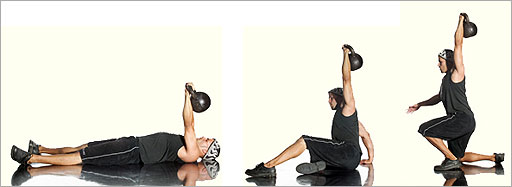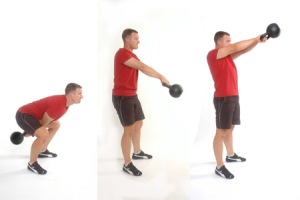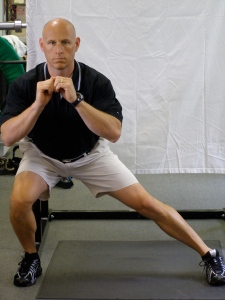
By Alwyn Cosgrove
When I started out in the fitness-training field, the average client tended to be an active person who used gym exercise to augment the other types of activity he got outside the gym. Few of us specialized in fat-loss training, simply because it wasn’t the primary goal of the majority of our clients. It was a nice side-effect of solid workouts and a good diet, but it wasn’t the main reason our clients came to work with us. Today, it’s the opposite. What we do with our clients in the gym may be the only exercise they get in a typical week. We regularly see clients who work 50 hours a week, not counting the two hours a day they spend commuting. Many of them can’t train on weekends because of work-related travel, or because it’s the only chance they get to spent time with their spouses and kids. Since opening our facility in 2000, we’ve measured the body-fat percentages, abilities, range of motion, and posture of all our beginning members. I can say this unequivocally: The average beginner today arrives fatter and in worse shape than the average beginner just nine years ago. That presents a huge problem for us. We have to address posture, strength, mobility, flexibility, elasticity, and cardio-respiratory endurance simultaneously. And we’re lucky if we get three hours a week to do it. A traditional program won’t work for this population. Now, before anyone counters with “dedicated people make time,” let me assure you that I’m talking about people who are dedicated. Let me describe two of my former clients:
Client #1: a professional motocross rider • Races 45 weekends a year • Flies out to the race site on Friday, competes Saturday and Sunday, and flies home on Monday • Practices Tuesday, Wednesday, and Thursday • Trains with me Tuesday and Thursday • Starts all over again on Friday This is a guy who’s married, with two young sons. Is he not dedicated? Do you see any additional room in his schedule that would allow him to train more than he does?
Client #2: a doctor • Works 60 to 70 hours a week, and is often on call longer than that • Commutes an hour to work each way • Married with three kids • Attends his kids’ soccer games, and tries to spend to spend as much time as possible with his family • Trains with me three times a week Is he not a dedicated person? Should he devote more hours to the gym, at the expense of saving lives or spending time with his family?
The solution: To give these dedicated but time-challenged clients the best possible results, we need to hack traditional training down to its most basic and fundamental elements. Hacking 101 You may be familiar with the term “life hack.” Basically, it’s a time-management system in which you hack away the unessential stuff in your life to increase productivity. If we define productivity as “maximizing results per unit of time invested,” we can see the benefits of it. The goal is to spend less time doing things that bring us little if any benefit, and more time doing the things that improve our income, prospects, pleasure, and quality of life. Another way to look at it: maximize productivity by minimizing redundancy. As a fitness professional and owner of a training facility, I realized I had to hack our training programs if I had any hope of keeping pace with the rapidly changing needs of our clients. For example, it’s not uncommon to see programs that include three exercises or more for each body part. So for biceps, you might see the barbell curl, EZ-bar curl, and seated dumbbell curl — three exercises that are more similar than different. Barbell curls, EZ-bar curls, and seated dumbbell curls are essentially the same exercise. Our first hack would be to switch to barbell curls and incline dumbbell curls. Now we’ve reduced the total number of exercises by a third, and we’ve also chosen a non-redundant exercise — the incline curl — to give us a different angle of pull and allow us to hit more muscle fibers. A second hack would choose one of those exercises as our sole focus. A third and final hack — the “max hack” — would eliminate the isolation work completely. Instead, we’d do close-grip chins, which would target the biceps effectively enough while also recruiting lots more muscle and building total-body strength.
Body by Pareto The Pareto principle, also known as the 80-20 rule, is an important key to successful hacking of any type — whether we’re talking about training, running a business, or the overall management of our lives. It’s named for Vilfredo Pareto, an Italian economist who in 1906 observed that 80 percent of the wealth in Italy (and every country he subsequently studied) was owned by 20 percent of the population. After Pareto published his findings, many others observed similar ratios in their own areas of expertise. In the early 1940s, an industrial-efficiency expert named Joseph Juran applied Pareto’s ideas to project management, describing the principle of “the vital few and trivial many.” Tim Ferriss, author of The 4-Hour Workweek, popularized the idea for my generation of entrepreneurs when he observed that 80 percent of his income came from 20 percent of his clients. So he hacked off 80 percent of his clients, effectively reducing his workload by 80 percent, and focused on the clients who accounted for 80 percent of his income. Yes, at first he took a 20 percent pay cut, but his productivity and income soared on a per-hour basis. You can apply the Pareto principle to workout hacking with the assumption that 80 percent of the consequences come from 20 percent of the causes. Or, put another way, 20 percent of the exercises you do produce 80 percent of your results. Let’s say you have a total-body workout with 10 exercises. If we hacked out eight of the 10 exercises, and just kept squats and chin-ups, would you expect to get just 20 percent of the results? Chances are it would be the opposite — you might get 80 percent of the results by focusing on just 20 percent of the exercises. So most of your results come from just two exercises, and relatively few results come from the other eight. It’s easy to see why. Compound exercises recruit more muscle, allow you to use bigger loads, and burn more calories than isolation exercises. That’s why you want to build your program around them, and why your workouts should start with exercises like deadlifts or squats, the ones that produce the best results on a rep-by-rep basis.
Now, I’m not suggesting that you’ll get 100 percent of the results you want with a hacked program. The goal of hacking out what’s unessential from your training program is to free up more of your time without significantly diminishing your results. Don’t hack for the sake of hacking; you want to eliminate redundant or trivially beneficial exercises so you can accomplish other goals, in or out of the gym. In the next few sections I’ll show you examples we’ve used successfully with clients in our facility. As you’ll see, there’s a sound basis in science for most of these hacks.
The Frequency and Volume Hack Back in 2000, a study published in the Journal of Strength and Conditioning Research compared equal-volume resistance training over one day or three days per week. [1] The participants in the study were experienced lifters. Group one performed the entire workout — three sets of each exercise — on one day. Group two performed the same volume of work, but spread it out over three days. So they did one set of each exercise in each workout. The researchers found that the once-per-week group achieved just 62 percent of the strength improvements of the three-times-per-week group, and also gained less muscle. The men in the second group put on nine pounds of muscle, vs. four pounds for those in the first group. This gives us an idea of how to start our training hack: It’s better to reduce volume per workout than it is to reduce frequency. So if you work out three times a week, it’s better to make those workouts shorter than to do longer workouts less often.
A review published in Sports Medicine in 2007 looked at several studies on strength training and hypertrophy across different populations.[2] It concluded that, for hypertrophy, it’s better to train each muscle group three times a week. Anecdotally, we know that a lot of bodybuilders use an increased frequency to bring up a lagging body part. If the problem is that every body part needs to be brought up, then three total-body workouts should work better than a series of split routines in which body parts are hit just once or twice per week. The Sets and Reps Hack Now that we’ve settled on three total-body workouts a week, we have to figure out how to hack unessential elements of those workouts to keep them at a reasonable length. But we still want results, so we have to figure out how best to employ sets and reps to increase size and strength.
A study published in JSCR in 2002 compared two different types of periodization.[3] Traditional linear periodization works something like this: In weeks one to four, you’d do eight reps per set of all your exercises. In weeks five to eight, you’d do six reps, and in weeks nine to 12 you’d do four reps. So you’d progress from a hypertrophy protocol to one that emphasizes pure strength. Undulating periodization aims to achieve those goals simultaneously, so on Monday you’d do four reps per set, on Wednesday you’d do six reps, and on Friday you’d do eight reps. The researchers found that undulating periodization was better than linear periodization for strength gains. Thus, we’ll use three distinct ranges of sets and reps in our three total-body workouts each week. That brings us to the next big question: Which exercises should we use?
Exercise Hack At the 2000 annual conference of the National Strength and Conditioning Association, researchers at Ball State presented a study that compared the effects of two different workouts on upper-arm circumference.[4] One group did four compound upper-body exercises in each workout, while the other did those four exercises plus biceps curls and triceps extensions. Both groups increased their strength and arm size. But in 10 weeks of training, the additional arm exercises provided no additional benefit. So if you’re going to hack your training program to make it as efficient as possible without sacrificing benefits, you can eliminate direct arm training with isolation exercises. Big arms, no curls. Workout Duration Hack Sir Charles Scott Sherrington won the Nobel Prize in 1932 for his contributions in physiology and neuroscience. Sherrington’s law of reciprocal innervation states that “for every neural activation of a muscle, there is a corresponding inhibition of the opposing muscle.” This means that when you work your chest muscles, the opposite back muscles are forced to relax, thereby resting. It’s easy to apply this one: Instead of waiting two minutes between sets of bench presses, for example, you can perform one set of the bench press, rest for one minute, and then do a bent-over row. After you finish, you’ll rest for one minute, then repeat the sequence until you complete all sets of both exercises. In an average workout, this technique saves at least eight to 10 minutes without sacrificing performance.
“If you could only do one exercise … ” I hate questions like this. But I do have an answer: The snatch-grip deadlift probably works more muscle through a bigger range of motion than any other single exercise. (In other words, I’m not comparing the snatch-grip deadlift to a combination exercise like the clean and press.) So we’ll start with that as our primary exercise. Our secondary exercise will be the front squat. I also like to do single-leg exercises, so we’ll create a second total-body workout in which we use dumbbell Bulgarian split squats to target our quads, with step-ups as a hip-dominant counterpart. For upper-body exercises, we’ll stick to the ones that use the most muscle and avoid single-joint exercises.
The big four here will be chin-ups, dips (or dumbbell bench presses), dumbbell rows, and barbell push presses. We’ll do two of them in each of our total-body workouts.
Program A 1) Snatch-grip deadlift 2) Dumbbell Bulgarian split squat 3a) Dip 3b) Dumbbell row
Program B 1) Front squat 2) Step-up 3a) Barbell push press 3b) Close-grip chin-up Here’s how we’ll alternate programs A and B:
Week one: Mon: Program A Wed: Program B Fri: Program A Week two: Mon: Program B Wed: Program A Fri: Program B
Sets and reps for A and B work like this: Mon: 4 sets of 4 reps of each exercise. Rest 90 to 120 seconds between sets. Wed: 3 sets of 8 reps of each exercise. Rest 75 to 90 seconds between sets. Fri: 2 to 3 sets of 12 reps of each exercise. Rest 60 to 75 seconds between sets.
Select a load that’s appropriate for each exercise, given the rep range. You want to stop one or two reps short of failure on each set. Try this system as written for up to six weeks. You’ll do each program nine times, but only three times at each rep range. Final Thoughts Is this the perfect program? Absolutely not — the perfect program doesn’t exist. It’s just one way to hack out the unessential, trivial, and redundant exercises from your program, replacing them with the most effective exercises, and employing them in the most time-efficient way I know. Does it work? Let me put it this way: I wouldn’t still be in business if it didn’t.
Great Stuff!
Get Strong! Stay Strong!
Chris




















 <———->
<———-> 










